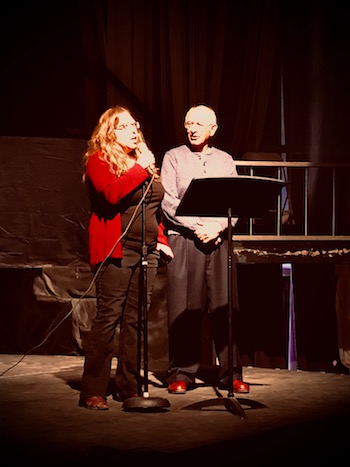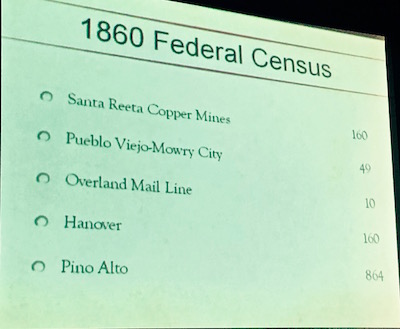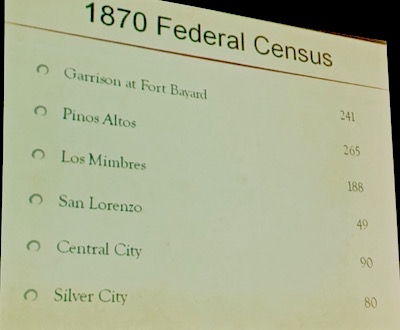 Unidentified woman introduces Dr. Don MontoyaPhoto and article by Hallie Richwine
Unidentified woman introduces Dr. Don MontoyaPhoto and article by Hallie Richwine
This year’s celebration of Territorial Charter Day included a presentation on the economic and social conditions that led to the adoption of the Territorial Charter, presented by Dr. Don Montoya. The event was presented by the Silver City Museum and was held at the El Sol theater.
Montoya was born in Fierro, NM and has had family in the area for 100 years. He cited his source material as the newspapers of the time, mining claims, homestead records, and federal census records. His focus was specifically on the changes in Silver City between 1875 and 1877, just prior to the adoption of the Silver City Charter.
The territory itself belonged to Spain until 1821 when Mexico declared its independence, by the end of the Mexican-American war in 1848. The signing of the 1848 Treaty of Guadalupe Hidalgo ended the war and enforced the Mexican Cession of its northern territories, one of which was Santa Fe de Nuevo México.
In 1850 the New Mexico territory as well as Arizona was recognized as formal territory, and by 1852 the New Mexico territorial legislature divided the area into nine counties. Records show Santa Rita as the largest community at that time; the mine there had been active since the early 1800s. Fort Webster was moved to the Mimbres in 1852, although it was short-lived due to difficulty bringing in supplies.
 1860 federal census reports showed growth in the mining communities as well as misspellings of the town names. “Gold was reported in Spring of 1860 and by the August federal census the communities of Santa Rita and Pinos Altos showed growth. Most of these people were more or less squatters, many of whom were prospectors from Mesilla,” Montoya said.
1860 federal census reports showed growth in the mining communities as well as misspellings of the town names. “Gold was reported in Spring of 1860 and by the August federal census the communities of Santa Rita and Pinos Altos showed growth. Most of these people were more or less squatters, many of whom were prospectors from Mesilla,” Montoya said.
Montoya described the political changes taking place. The first rebellion of the southern portion of New Mexico was in 1856 when the area between Tucson and Mesilla claimed to be disenfranchised from the northern part of the territory. Tucson was the closest large city (rather than Santa Fe), and the distance was multiplied by the poor state of the roads. The problems cited were inadequate representation, an insufficient court system, and deficiency in law enforcement. The desire to separate led to a convention where they proposed to divide the territory from east to west. They elected Nathan P. Cook to represent them and sent him to Washington, D.C. to initiate the separation. Congress never seated him and rebellion activity died off.
The second attempt to secede came in 1860; a lot of secession turmoil was happening in Washington, D.C. The second time the citizens of Southern New Mexico tried was in April of 1860 when they held a Constitutional Convention in Tucson, NM, with the same complaints as four years earlier. They formed the Arizona territory, with the border near where the Casa Grande National Monument is located. Retired Union officer Sylvester Mowry went to Washington, D.C. and was also not seated by Congress.
Around this time there was an increase in Texan interest in the more populated areas in an effort to entice the territory to secede. Texas seceded in 1861, the same time that another convention was being held in Mesilla to vote on a resolution to join the Confederacy. The depopulation of these communities as a result of the Civil War was misinterpreted by the Apache as weakness.
In February of 1863, New Mexico and Arizona were created, but not East to West as proposed earlier, but North to South as it is today. After the Civil War people were returning to the mining sites on account of the mineral wealth. The Bullard brothers were homesteading in La Cienega de San Vicente on 320 acres. When silver and gold were found south of town in the town of Lawston, Bullard was shown silver and the legend is that he said, “If that’s silver then I know where there is a lot of it,.” When Bullard was back at La Cienega de San Vicente, a lot of raw silver was found just to the west, and once again prospectors from Mesilla were drawn to the area. La Cienega de San Vicente was abandoned and Silver City was formed.
The Territorial Legislature created Grant County in January of 1868, with the first County Commission that April.
 The 1870 federal census shows the shift in population among the communities and the establishment of Silver City.The first federal census of Silver City was in 1870. By 1875 there was a tremendous amount of activity in Silver City. Mines and smelters were active. There would have been intense noise from the mill, and dirt roads would have been difficult in both the windy and rainy seasons. Montoya said the town was quite different from the community we have today.
The 1870 federal census shows the shift in population among the communities and the establishment of Silver City.The first federal census of Silver City was in 1870. By 1875 there was a tremendous amount of activity in Silver City. Mines and smelters were active. There would have been intense noise from the mill, and dirt roads would have been difficult in both the windy and rainy seasons. Montoya said the town was quite different from the community we have today.
At this time Silver City exported silver and gold ingots in large quantities weekly, which was well advertised in the newspapers. Merchants were importing 5-6 million pounds of goods including mining equipment. The Mimbres and Gila valleys were the breadbaskets of the community, growing corn, wheat, beans, and fresh vegetables. “Most importantly, they grew hops for the local breweries to keep the nine saloons in business,” Montoya added. In addition to the shops and saloons there were multiple hotels and news agencies.
“John Chisum, the cattle baron from Texas, came scouting. Local ranchers were not interested, and when he and his lawyer were leaving town they were robbed. Around this time the newspaper stopped publishing the amount of silver and gold being sent out,” Montoya said.
In 1876 telegraph lines came to Silver City. “There was a two day celebration,” Montoya said, “which included drinking and gunfire. It also included anvil shooting, which is when you put down an anvil, then gunpowder and a fuse, then another anvil and shoot it into the air.”
“The territorial ring, also known as the Santa Fe ring, was an amorphous group formed primarily of lawyers, politicians, and wealthy people that controlled the territorial legislature,” Montoya said. Key players were Steven Elkins, Thomas Catron, Richard Hudson, William Rynerson, and Governor Giddings.
Montoya described the first Fourth of July celebrations held by the town. The first celebration took place in 1873, which included a baseball game and northern and southern orators and concluded with dinner, dancing, and fireworks. 1874 was similar but with a picnic. In 1875, the celebration slipped through the cracks, which almost happened in 1876 until a soldier at Fort Bayard asked why the town wasn’t having centennial activities. Stands were built for musicians and orators; men worked through the night to get everything completed on time. At dawn, a thirteen-gun salute announced the event. All businesses closed, and a parade formed on Main Street which included the Fort Bayard band, color bearers, the firemen, the liberty car, and schoolchildren. The liberty car was a wagon festooned with the American flag with thirteen ladies in red and white dresses with blue ribbons with the names of the original colonies on them. After the parade started with speeches, fifteen minutes of gunfire, and the band began to play. Horse races and baseball were cancelled on account of rain. The 1877 celebration was smaller and was located at Fort Bayard.
The annexation campaign to Arizona began. “People had long memories and recalled the fiascos in 1856 and 1860,” Montoya said. The Santa Fe Ring was troublesome and during the 1871-1872 Territorial Legislature session when the Democrats took control of the council it was chaotic. The Democrats were anti-Santa Fe Ring, and Governor Giddings called the federal police in to keep the peace.
“During this session representative Johnson from Silver City proposed an act of incorporation for the city as well as authorization for the establishment of effective schools,” Montoya said. Governor Giddings refused to consider the proposals. “In 1872 Giddings added insult to injury when Grant, Dona Ana, and Luna counties were only given two representatives among them, rather than one apiece,” Montoya said.
“By 1876 the citizens of Grant County had had enough,” he continued. “This was it. They had a meeting and they proclaimed a declaration of independence. They had the same reasoning as they did in 1856 and 1860. They wanted to get away from the Santa Fe Ring and they also felt the mining laws of Arizona were more similar to the mining interests of Grant County.” Being denied equal representation and the proximity to Tucson were factors, too.
On November 7, 1876 a non-partisan vote took place to see if Silver City wanted to join Arizona, which resulted in a unanimous outcome. “The town was excited about joining Arizona. Governor Safford was delighted to accept Grant County because of the mineral wealth and recommended it to the Arizona legislature, but that fell on deaf ears,” Montoya said. In 1877 there was a bill to annex Grant County to Arizona in Congress, which failed.
 Montoya was surprised to find the passage of the bill on the third page rather than the first. On May 16, 1877, Governor Axtell, who was a friend to Silver City, approved the Silver City Incorporation Act. On February 2, 1878, the bill to incorporate Silver City was introduced to the Territorial Legislature. On February, 14, 1878, the Senate passed the bill and a notice appeared on the third page of the newspaper.
Montoya was surprised to find the passage of the bill on the third page rather than the first. On May 16, 1877, Governor Axtell, who was a friend to Silver City, approved the Silver City Incorporation Act. On February 2, 1878, the bill to incorporate Silver City was introduced to the Territorial Legislature. On February, 14, 1878, the Senate passed the bill and a notice appeared on the third page of the newspaper.


